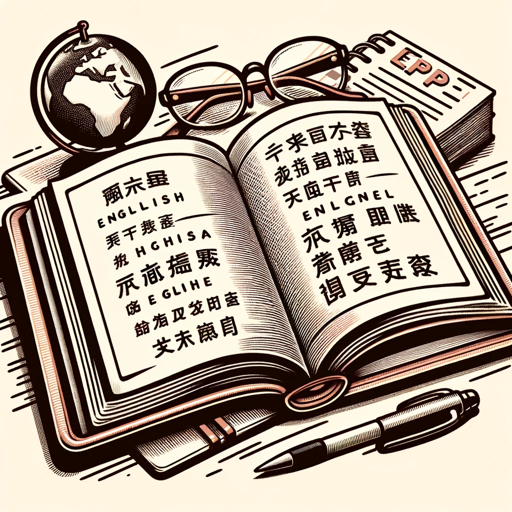翻訳-accurate translation service
AI-powered precision for your translations
Related Tools
Load More翻訳君
原文をコピペするだけで翻訳してくれます。デフォルトでは日→英、または全ての外国語→日。

日↔英 翻訳機
Simple and high-performance English-Japanese bidirectional translator

中英文对照翻译
将英文翻译成中英文对照的内容。

00コピペ英文和訳・和文英訳
文章をコピペしてください。AIが自動判別して、英文は和訳し、和文は英訳します。

和訳GPT
全文を一言一句日本語に翻訳してくれるGPTs (生成エラー対策として”生成を続ける”は使わず、手動でcontinueなどと入力することをお勧めします)

Translate to Japanese
Translate any Language to Japanese
20.0 / 5 (200 votes)
Introduction to 翻訳
翻訳, which means 'translation' in Japanese, is a specialized AI tool designed to assist users in translating text between Japanese and English. The primary purpose of 翻訳 is to facilitate accurate and context-aware translations that go beyond simple word-for-word conversion. The design is focused on delivering translations that preserve the nuance, tone, and intent of the original text, making it particularly useful for users who require high-quality translations for business, academic, or personal purposes. For example, in a scenario where a business needs to translate a legal document from Japanese to English, 翻訳 ensures that legal terms are correctly interpreted and that the translation maintains the formal tone of the original document. In another case, if a user needs to translate a casual conversation from English to Japanese, 翻訳 can adjust the language to fit the informal context, ensuring the translation feels natural to a native speaker.

Main Functions of 翻訳
Bidirectional Text Translation
Example
Translating a Japanese business report into English while maintaining technical accuracy.
Scenario
A Japanese company preparing a report for its international stakeholders needs an accurate and professional translation of technical content. 翻訳 handles this by ensuring that the industry-specific terminology is translated correctly and that the overall tone is appropriate for the business context.
Context-Aware Translations
Example
Translating a Japanese blog post into English with cultural nuances intact.
Scenario
A Japanese blogger writing about cultural traditions wants to share their content with an English-speaking audience. 翻訳 ensures that cultural references and idiomatic expressions are translated in a way that is understandable and meaningful to readers in the target language.
Tone and Register Adaptation
Example
Converting an informal English email into polite Japanese correspondence.
Scenario
An English-speaking professional needs to send a polite email to a Japanese client. 翻訳 adapts the tone of the email to align with Japanese business etiquette, ensuring the message is conveyed respectfully and appropriately.
Ideal Users of 翻訳 Services
Business Professionals
Business professionals who engage in international trade or collaboration between Japan and English-speaking countries benefit greatly from 翻訳. They need precise translations of contracts, reports, and correspondence to ensure clarity and professionalism in their communications.
Academics and Researchers
Academics who publish research in both Japanese and English can use 翻訳 to ensure their work is accurately translated, preserving the integrity of complex ideas and technical jargon across languages. This service is particularly valuable in fields like science, technology, and humanities, where precise language is crucial.
Content Creators and Bloggers
Content creators who want to reach a broader audience by translating their work from Japanese to English or vice versa can use 翻訳 to maintain the original tone and cultural nuances of their content, making it relatable and engaging for readers in different languages.

How to Use 翻訳
1
Visit aichatonline.org for a free trial without login, also no need for ChatGPT Plus.
2
Select the language of your input and the desired target language for translation. Ensure your text is clear and contextually complete for the best results.
3
Enter or paste your text into the provided text box. Review the input for any specialized terminology or phrases that might need contextual consideration.
4
Click the 'Translate' button. Review the translation for accuracy and contextual fidelity. Adjust your input text if needed and re-translate.
5
Utilize the translated text in your desired context, whether it's for academic writing, professional communication, or personal use. Repeat the process as needed for different sections or texts.
Try other advanced and practical GPTs
Copywriter Assistant
AI-Powered Writing Made Easy

画像生成
Create Stunning Images with AI Power

Neo Coder
Empowering Your Code with AI

Mr Beast
Maximize Your YouTube Potential with AI Insights

Buddha
AI wisdom for modern needs.

Crypto Venture Analyst
AI-powered insights for crypto investments.

Adzviser: Marketing & Ads Data Analytics
AI-powered Marketing Insights and Optimization.

Blog Expert - SEO Blogs made easy!
AI-powered SEO blog creation.

Anime Girls GPT
AI-powered anime girl generator

Explicador: Experto haciendo resúmenes
AI-powered concise summaries.
SharkTankGPT
AI-Powered Business Pitch Evaluator

Namesake
AI-Powered Creativity for Unique Names.

- Academic Writing
- Business Communication
- Legal Documents
- Technical Translation
- Everyday Use
Common Questions About 翻訳
What is 翻訳 primarily used for?
翻訳 is primarily used for translating text between English and Japanese. It's ideal for academic writing, professional documents, and everyday communication requiring precise language translation.
How accurate are the translations provided by 翻訳?
The translations are highly accurate, particularly when the input text is clear and contextually complete. While 翻訳 excels in accuracy, users are encouraged to review the output to ensure it meets specific contextual needs.
Can 翻訳 handle specialized or technical language?
Yes, 翻訳 can handle specialized and technical language. However, it's important to provide clear context in the input text to ensure the translation is accurate for niche fields or industry-specific terminology.
Is 翻訳 suitable for professional use?
Absolutely. 翻訳 is suitable for professional use, especially in fields like business, legal, and academic settings where precise translation is crucial. It can be used to translate documents, emails, reports, and more.
Are there any prerequisites for using 翻訳?
No special prerequisites are required. Simply access the platform, select your languages, and input your text. However, understanding the nuances of both source and target languages can enhance the translation's accuracy.